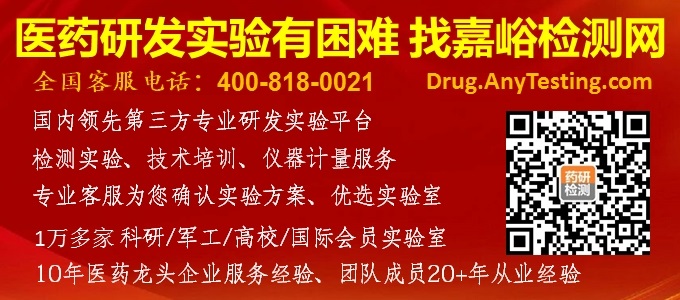您当前的位置:检测资讯 > 法规标准
嘉峪检测网 2021-02-21 08:34
Nitrosamine Impurities in Medicines: FDA’s Continuing Multidisciplinary Response
药品中的亚硝胺杂质:FDA的持续多学科响应
In June 2018, the FDA learned that certain generic versions of valsartan, a high blood pressure and heart failure medication, contained unexpected impurities that posed a potential safety concern. These impurities, known as nitrosamines, are probable carcinogens that may increase the risk of cancer in humans. They include N-Nitrosodimethylamine (NDMA), N-Nitrosodiethylamine (NDEA), N-nitroso-N-methyl-4-aminobutanoic acid (NMBA), N-nitrosoisopropylethyl amine (NIPEA), N-nitrosomethylphenylamine (NMPA), 1-methyl-4-nitrosopiperazine (MNP), and 1-cyclopentyl-4-nitrosopiperazine (CPNP). There are many reasons why nitrosamines can be present in medications, including a drug’s manufacturing process, its chemical structure, or the conditions in which it is stored or packaged.
2018年6月,FDA了解到有些缬沙坦仿制药(一种高血压和心力衰竭治疗用药)中含有非预期杂质,有潜在安全问题。这些杂质已知是亚硝胺,是可能的致癌物,可增加人类患癌风险。亚硝胺包括有NDMA、NDEA、NMBA、NIPEA、NMPA、MNP(1-甲基-4-亚硝基哌嗪)和CPNP(1-环戊基-4-亚硝基哌嗪)。药品中出现亚硝胺的原因有许多,包括药品的生产工艺、其化学结构,以及药品的存贮条件和包装条件。
Since the initial discovery of NDMA in valsartan, FDA scientists and regulators have investigated nitrosamine impurities in other products, including the heartburn medications ranitidine and nizatidine, the type 2 diabetes medication metformin, and the tuberculosis medications rifampin and rifapentine. The Agency has developed appropriate test methods for testing for these impurities in specific drug products, has tested drug products and drug substances, sent information requests to applicants and manufacturers of drug products suspected of containing nitrosamine impurities, and evaluated the information received from industry. It has assisted industry in initiating voluntary recalls of products when nitrosamines have been found above an acceptable level, and worked with industry when changes to manufacturing processes were appropriate. Throughout this process FDA has kept industry, health practitioners and the public informed of our investigation and regulatory actions. Timely communication o fthis information has provided health care professionals, patients, consumers and other interested persons with access to the most current information concerning the potential risks and benefits of marketed drugs, helping them to make more informed treatment choices.
自从在缬沙坦中首次发现NDMA以来,FDA科学家和监管人员对其它药品中的亚硝胺杂质进行了调查,包括胃灼烧药品雷尼替丁和尼扎替丁,II型糖尿病用药二甲双胍,以及结核病用药利福平和利福喷丁。FDA已开发出适当的检测方法用于特定药品中这些杂质的检测,并对制剂和原料药进行了检查,要求申报人和疑似含有亚硝胺杂质的药品生产商提交资料,并评估了企业提供的相关资料。FDA的工作帮助了企业主动召回发现亚硝胺杂质高于可接受水平的药品。在这些工作中,FDA一直向企业、卫生工作人员和公众提供我们的调查和监管措施信息。对这些信息的及时沟通使得卫生工作人员、患者、消费者和其它利益相关方可获得最新的已上市药品的潜在利弊资料,帮助他们更好了解治疗选择。
Ranitidine雷尼替丁
All of FDA’s 2020 updates and actions on ranitidine are available online. On April 1, FDAannounced it was requesting manufacturers withdraw all prescription and over-the-counter (OTC) ranitidine medications from the market immediately. The Agency determined the NDMA impurity in some ranitidine products increases over time and when stored at higher than room temperatures and may result in consumer exposure to unacceptable levels of this impurity.
所有FDA在2020年的更新和措施均可在线查找。4月1日,FDA宣布要求生产商立即从市场上撤回所有处方和OTC雷尼替丁药品。FDA检测发现有些雷尼替丁药品中的NDMA杂质随时间而增长,并且在存贮温度高于室温时可能会导致使用者暴露于不可接受水平的该杂质中。
Metformin 二甲双胍
The full timeline of announcements, statements, and actions related to metformin products is available online. Key 2020 actions addressing NDMA impurities in metformin products include:
与二甲双胍有关的全部公告、声明和措施时间线可在线查到。二甲双胍药品中NDMA杂质在2020年关键措施包括:
FEBRUARY 3 | FDA announced that it posted laboratory results showing NDMA levels in some metformin products approved in the United States. The Agency determined that the levels of NDMA in the metformin products tested ranged from not detectable to low levels.
2月3日,FDA宣布发布美国批准的有些二甲双胍药品中的NDMA水平的实验室结果。FDA检测显示二甲双胍药品中的NDMA从未检出到较低水平。
MAY 28| FDA alerted patients and health care professionals that laboratory testing revealed levels of NDMA above the Agency’s acceptable intake limit in several lots of the extended release (ER) formulation of metformin.
5月28日,FDA警示患者和卫生工作人员,实验室检测显示几个批次的缓释(ER)二甲双胍制剂中NDMA水平超出FDA认定的可接受摄入限度。
JUNE 11 | FDA named fivecompanies that voluntarily recalled certain ER metformin and updated the Agency’s laboratory test results showing the levels of NDMA it found in samples of metformin to date. FDA also posted a second liquid chromatography-electrosprayionization-high resolution mass spectrometry (LC-ESI-HRMS) testing method to provide an option for regulators and industry to detect eight different nitrosamine impurities in metformin drug substances and products.
6月11日,FDA点名要求5家公司主动召回特定ER二甲双胍,并更新了FDA实验室截止当时所检测出的NDMA水平。FDA亦发布了第二个LC-ESI-HRMS检测方法,为药监机构和企业提供检测二甲双胍原料药和制剂中8种不同亚硝胺杂质的方法选择。
JULY 2 | The AAPS Journal, an official journal of the American Association of Pharmaceutical Scientists, published FDA’s manuscript titled, “A Cautionary Tale: Quantitative LC-HRMS AnalyticalProcedures for the Analysis of N-Nitrosodimethylamine in Metformin.” This article assessed the cause for the discrepancy between the NDMA values FDA found in its testing of metformin drug products and the values a private laboratory reported. In summary, FDA found the private laboratory method to be inappropriate for quantifying NDMA in metformin drug products due to presumptive overestimation of NDMA caused by the presence of a substance that interfered with the testing results. This article emphasized the importance of the use of appropriate test methodology. If FDA relied upon the data from inappropriate test methods, drug products approved by FDA may have been removed or voluntarily recalled from the market causing unnecessary disruption to patients and health care providers.
7月2日,APPS杂质(美国药物科学家官方杂志)发布了FDA题为“警示故事:二甲双胍中定量检测N-二甲基亚硝胺LC-HRMS分析方法”的文章。该篇文章评估了FDA在其对二甲双胍药品中检测所得NDMA值与私人实验室所报告的值之间的差异。简单地说就是FDA发现私人实验室的方法并不适合对二甲双胍制剂中的NDMA进行定量分析,因为存在一种物质影响了检测结果,所以NDMA结果虚高。该文章强调了使用恰当的检测方法的重要性。如果FDA依赖于不恰当的检测方法所得数据,则由FDA批准的数据可能会从市场召回或移除,从而不必要地导致患者和卫生工作人员缺少该药品。
JULY 13 | FDA announced that several companies voluntarily recalled ER metformin medications due to the possibility they could contain NDMA above the acceptable intake limit. FDA also published a recalled metformin list that included details about metformin products that had been recalled, which has since been updated.
7月13日,FDA宣布几家公司因其ER二甲双胍药品中可能含有NDMA超出不可接受的摄入限度,因此主动召回。FDA还发布了二甲双胍召回清单,包括已被召回的二甲双胍药品,这些均已进行了更新。
Rifampin and Rifapentine 利福平与利福喷丁
AUGUST 26 | FDA announced it was aware of nitrosamine impurities in certain samples of rifampin and rifapentine, which are antibacterial medications used to treat tuberculosis. The Agency identified rifampin containing MNP and rifapentine containing CPNP above the acceptable intake limits. FDA has been investigating this problem and isworking with manufacturers to permit temporary distribution of these drug products to avoid shortages and to help ensure patients continued to have access to these necessary medications, until manufacturers can reduce oreliminate the impurities. FDA announced it would not object if certain manufacturers temporarily distributed rifampin containing MNP below 5 parts permillion (PPM), and rifapentine containing CPNP below 14 ppm.
8月26日,FDA宣布其了解到一些利福平与利福喷丁样本中含有亚硝胺杂质,该药品为抗菌药品,用于治疗结核病。FDA发现利福平中含有的MNP和利福喷丁超出了可接受的摄入限度。FDA已对此问题进行了调查,并与生产商一起努力,暂时允许销售这些药品,以避免药品短缺,并帮助确保患者继续获得这些必要的药品,直至生产商能够降低或清除这些杂质。FDA宣布不会对暂时销售含有NMP低于5ppm的利福平,以及含CPNP低于14ppm的利福喷丁的生产商采取措施。
SEPTEMBER 2 | FDA published a LC-ESI-HRMS testing method to provide an option for regulators and industry to detect nitrosamine impurities in rifampin and rifapentine.
9月2日,FDA发布了一个LC-ESI-HRMS方法,为监管方和企业提供了检测利福平和利福喷丁中亚硝胺杂质的方法。
OCTOBER 29 | To continue to mitigate or avoid a shortage, FDA announced it would not object to certain manufacturers temporarily distributing rifapentine containing CPNP at or below 20 ppm to help ensure patients had continued access to the medication.
10月29日,为继续缓解和避免药品短缺,FDA宣布其不会对临时销售含CPNP等于低于20ppm的利福喷丁的生产商采取措施,以帮助确保患者继续获得该药品。
FDA Guidance for Industry FDA的行业指南
On September 1, FDA announced the publication of the guidance “Controlof Nitrosamine Impurities in Human Drugs. ” The guidance recommends steps manufacturers of active pharmaceutical ingredients (APIs) and drug products should take to detect and prevent unacceptable levels of nitrosamine impurities in their drugs. The guidance also describes conditions that may introduce nitrosamine impurities. On October 2, FDA held a Small Business and Industry Assistance webinar to explain the guidance.
9月1日,FDA发布“人药中亚硝胺杂质的控制”指南。该指南建议API和制剂生产商应采取的检测和防止其药品中亚硝胺杂质达到不可接受水平的措施。该指南亦描述了可能会引入亚硝胺杂质的条件。10月1日,FDA召开了中小企业网络培训对该该指南进行了解释。

来源:Julia法规翻译


